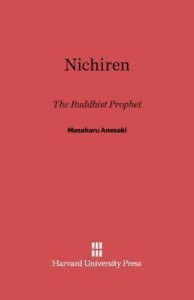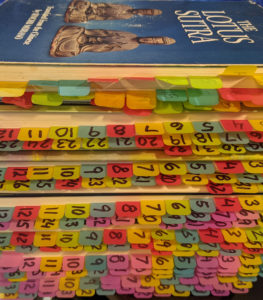 In August I was browsing books on Nichiren available on Google Books and stumbled upon Masaharu Anesaki’s book, “Nichiren, The Buddhist Prophet.”
In August I was browsing books on Nichiren available on Google Books and stumbled upon Masaharu Anesaki’s book, “Nichiren, The Buddhist Prophet.”
The book, which is now in the public domain, was published in 1918 when the study of religious psychology was a new domain and a university professor could focus his academic career on “the science of religion.”
What sold me on downloading the book was this line from the introduction:
“In the present sketch all traditions and legends of later growth have been excluded, and all the main points, as well as many minor details, are related exclusively on the basis of Nichiren’s own statements. For this reason it may be regarded as virtually a record of Nichiren’s own confessions, and as such, it will, I hope, be found a useful study in the religious psychology of a prophetic leader.”
While I’m familiar with the biography of Nichiren and have read the seven volumes of his writings published by the Nichiren Shoshu and the two volumes of his work published by Soka Gakkai (yes, I intend to study the Nichiren Shu volumes as well), I haven’t before read a work quite like Anesaki’s book.
I’ve added more than 50 quotes from the book that I found inspiring. Of particular interest are the explanations of personal enlightenment.
For example:
[T]he object of worship, the Supreme Being is to be sought nowhere but in the innermost recess of every man’s nature, because the final aim of worship is the complete realization of the Supreme Being in ourselves.
And:
The attainment of Buddhahood is not a matter of individuals or of the aggregate of individuals, it is the embodiment of the all-embracing communion of all beings in the organic unity of Buddhahood which is inherent in them all.
And:
Then the store of truths (Buddha’s teachings), eighty-four thousand in the number of its gateways, is nothing but the record and diary of our own life. Everybody reads and embraces this store of truths in his own soul. Illusion occurs when we seek the Buddha, the Truth, and the Paradise outside of our own self. One who has realized this soul is called the Tathagata. When this state is once attained, (we realize that) the cosmos in ten directions is our own body, our own soul, and our manifestation, because the Tathagata is our own body and soul.
Of course, anyone who has read this book will at once remember Anesaki’s repeated efforts to explain Nichiren’s goals in terms of a Catholic Church of Buddhism.
As we have had repeated occasion to note, Nichiren associated every step of his life with some feature of the Scripture, and especially regarded his life in Sado as the chief part, the climax, of his life. Now the last stage was to be inaugurated, and dedicated to the consummation of his mission and to the perpetuation of his religion, just as the last twelve chapters of the Scripture made up the consummation of the Truth. He had proclaimed the Sacred Title at the outset of his ministry; he had furnished the object of worship and spiritual introspection by the graphic representation of the Supreme Being; one thing alone remained — to prepare for, or establish, the central seat of his religion. These three instruments of his propaganda were called the “Three Mysteries.” Although there are some allusions to them in his writings before this time, Nichiren proclaimed this trinity for the first time in the first essay written after his retirement. This treatise is dated the twenty-fourth of the fifth month (June 24) — just a week after his arrival at Minobu. The great plan which he had long been meditating, and the motive which led him to retire from the present world, and to work for the future, was the establishment of the “Kaidan,” or the Holy See of the Catholic Church of Buddhism.
I understand from discussions with people within Nichiren Shu that this issue of a physical Kaidan, sanctioned by the government and functioning as one true religion is a disputed area. Still, when placed in historical context …
I’ll admit that Anesaki’s use of the Catholic Church as metaphor gets a bit stretched at time:
The individual, the nation, the world, and the Kingdom of Buddha — these terms stand for different aspects of the one ideal. The Holy Catholic Church of Buddhism is to have the world, the whole cosmos, as its stage; while the cosmos is not to be conceived as a mere universe in space, but essentially exists in the heart of every true Buddhist. Buddha is the Father and Lord of the Kingdom, and his children should strive for the realization of the Kingdom both in their own lives and in the community of all beings.
Or:
‘Behold, the kingdom of God is within you!’ This was the creed of Nichiren also, witnessed by his life, confirmed by the Scripture, and supported by his metaphysical speculation. When he concentrated his thought on his own calling, he was in communion with the saints in the Lotus; when he expressed anxiety about his country, yet with confidence in its destiny, he was a prophet and an ideal patriot; when he reflected on his tranquil life among the mountains, he was almost a lyric poet, glorifying his surroundings by his religious vision; he was a scholastic philosopher when he interpreted the truths of existence and the nature of the religious community; and he was a mystic in his vision of the future realization of Buddhahood in himself and in the Kingdom of Buddha.
Christian metaphors aside, I strongly recommend this book.



